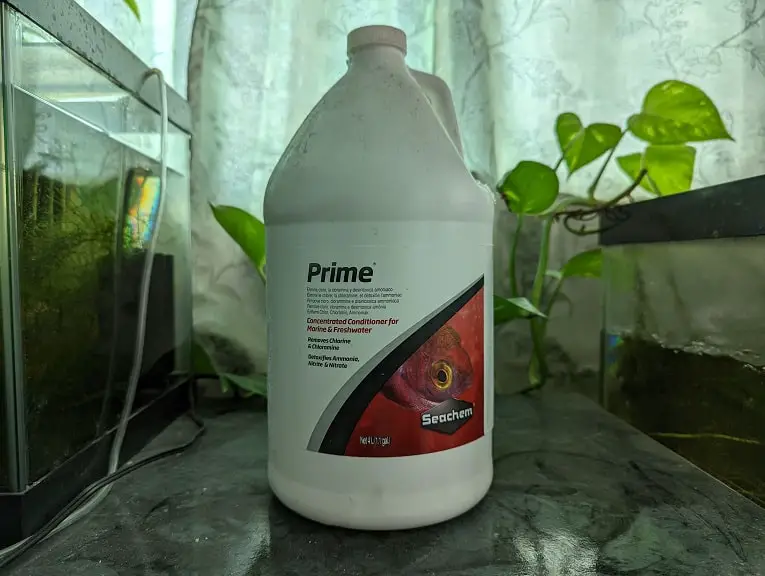Seachem has two similar water conditioners that you can use for both your fish tank as well as your pond. So, are there any differences between Prime and Pond Prime?
You can find out in this comparison article for these water conditioners at Aquarium Blueprints.
Quick Summary
The only difference between Seachem Prime and Seachem Pond Prime is that the regular Prime comes in smaller containers. On the other hand, Pond Prime is the only one that can be bought in a massive 20 L container.
Both water conditioners will remove chlorine, remove chloramine, detoxify heavy metals, detoxify ammonia, detoxify nitrites, detoxify nitrates and stimulate slime coat production.
In terms of dosage amounts, you should add 5 mL of either of these products for every 50 gallons or 200 liters of fish tank water.
For ponds, you should add 2.5 mL of Prime or Pond Prime for every 50 gallons or 200 liters of pond water.
Overall, you can’t go wrong with either Seachem Prime or Seachem Pond Prime as both offer the same benefits and come with the same dosage instructions.
Seachem Prime vs. Seachem Pond Matrix Comparison Chart
You can take a look at our comparison table for the Seachem Prime and Seachem Pond Prime below.
| Seachem Prime | Seachem Pond Matrix | |
|---|---|---|
| Packaging Sizes | 50 mL 100 mL 250 mL 500 mL 1 L 2 L 4 L | 500 mL 1 L 2 L 4 L 20 L |
| Recommended Fish Tank Dosage | 5 mL for every 50 gallons of 200 liters of tank water | 5 mL for every 50 gallons of 200 liters of tank water |
| Recommended Fish Pond Dosage | 2.5 mL for every 50 gallons of 200 liters of pond water | 2.5 mL for every 50 gallons of 200 liters of pond water |
| Remove Chlorine? | Yes | Yes |
| Remove Chloramine? | Yes | Yes |
| Detoxify Heavy Metals? | Yes | Yes |
| Detoxify Heavy Ammonia? | Yes | Yes |
| Detoxify Heavy Nitrites? | Yes | Yes |
| Detoxify Heavy Nitrates? | Yes | Yes |
| Stimulate Slime Coat Production? | Yes | Yes |
| Pricing | Check price on Amazon. (#CommissionsEarned) | Check price on Amazon. (#CommissionsEarned) |
Packaging Sizes
When it comes to the packaging sizes, the Seachem Prime offers smaller versions as it is the only one that comes in the 50 mL, 100 mL and 250 mL bottles. On the other hand, the Seachem Pond Matrix is the only product in this versus guide to come in a massive 20-liter bottle.
You can find the available packaging sizes for both products below:
Seachem Prime:
- 50 mL
- 100 mL
- 250 mL
- 500 mL
- 1 L
- 2 L
- 4 L

Seachem Pond Prime:
- 500 mL
- 1 L
- 2 L
- 4 L
- 20 L
Recommended Dosage
The recommended dosage amount for these two products should be the same.
If you are using these for your fish tank, then you should add 5 mL for every 50 gallons or 200 liters of the water volume.
Because a fish pond will most likely contain a lot more surface area, you can half your dose for Prime and Pond Prime. In this scenario, you only need to add 2.5 mL for every 50 gallons or 200 liters of the pond water volume.
Removing Chlorine and Chloramine
Both Seachem Prime and Seachem Pond Prime are designed to remove chlorine and chloramine. These two chemical compounds are mixed into the tap water.
If you are using tap water in your fish tank or fish pond, then the chlorine and chloramine could end up harming the beneficial bacteria living in your waters if they aren’t removed in a timely manner.
Detoxifying Heavy Metals
Some water sources may also contain heavy metals that may end up harming your fish. Prime and Pond may help detoxify small traces of these metals as well.
Detoxifying Ammonia
The organic wastes from your fish tank and fish pond will eventually decompose and turn into ammonia. When exposed, ammonia is very toxic to your fish and other aquatic pets.
By using Prime and Pond Prime, you should be able to turn ammonia into a non-toxic form for up to 48 hours.
Detoxifying Nitrites
Ammonia will eventually be converted to nitrites thanks to the beneficial bacteria living in your aquarium or pond. With that said, this can also be very toxic to your aquatic inhabitants.
Thankfully, both Seachem Prime and Seachem Pond Prime will detoxify nitrites temporarily for a maximum of 48 hours.
Detoxifying Nitrates
The last stage of the nitrogen cycle is nitrate, which is the end result of the beneficial bacteria in your tank or pond water consuming nitrites.
Nitrates is nowhere near as harmful as ammonia or nitrites. With that said, we recommend that you keep nitrate levels to below 40 ppm. If you are keeping more fragile fish or other aquatic species, then you should aim for less than 20 ppm.
If you ended up having a high number of nitrates in your waters, then you can use Prime or Pond Prime to turn the nitrogen compound non-toxic for up to 48 hours.
Stimulates Natural Slime Coat Production
Both Prime and Pond Prime should also help stimulate the natural slime coat production for your fish. For the uninformed, a slime coat should help prevent your pets from getting infected.
